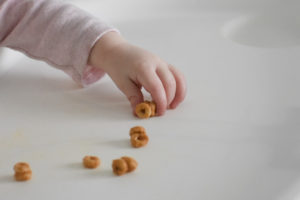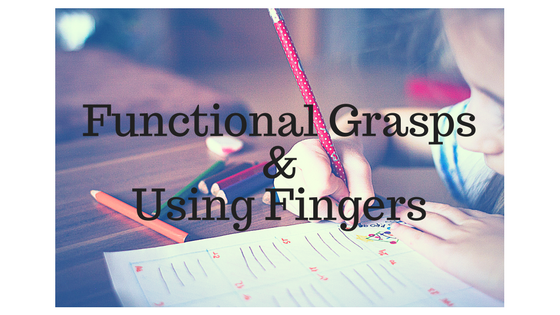Welcome back! This week we move on to the development of grasps that are more functional, meaning that they allow us to do specific tasks with more efficiency and skill, such as holding a pencil and writing. Also, we’ll touch on some of what kids’ fingers need to do to help them hold their pencils and things.
As babies develop, you will see them begin to use the pincer grasp. A pincer grip is the use of an index finger and thumb to pick up, hold, and release an object. This is a more precise and refined grip than the palmar grasp or cylindrical grasp. Although you probably hold an object with your thumb and index finger opposing each other, a child will initially use their thumb and the side of their index finger.
It is important for a child to develop this grasp as it is used for functional activities such as opening or closing buttons, zippers, laces, early handwriting, and scissor skills. Children will need to have mastered the pincer grasp to properly grip a pencil or pair of scissors.
When working with a child who is developing the pincer grasp, you want to encourage him to engage in fun activities that help develop and refine the pincer grip. Here’s a good list of ideas for activities:
- Using tweezers to pick up objects and dropping them into containers
- Threading beads
- Play-dough – pinching, squeezing, patting, poking and pulling it

- Pulling toys using a string
- Lacing and sewing boards
- Picking up small objects such as rice, beads, marbles, raisins and lentils between the thumb and forefinger and placing them into containers
- Tearing paper into strips
- Peeling off small stickers to make into a picture
- Turning pages in a book
- Making paper chains
- ‘Fuzzy Felt’
- Playing games with clothes pegs
- Making pipe cleaners into shapes, objects, or animals
- Popping bubble wrap
Let’s move to another developmental milestone which is important for young children as they use their hands more functionality. Finger isolation refers to the ability to point with one, specific finger at a time. This is important for your child to be able to do as it helps with the development of more refined grasps such as the pincer grasp and pencil grip, and will aid them with functional activities such as handwriting, using scissors, opening and closing buttons, using zippers and laces, and using a knife and fork.
There are a bunch of good activities you can do with children to help promote finger isolation:
- Drawing in shaving foam or whipped cream with a finger
- Flicking a ping-pong ball or cotton wool ball using fingers
- Playing with finger puppets
- Finger rhymes such as ‘Round and round the garden like a teddy bear’ or ‘Eensy weensy spider’
- Using a typewriter, keyboard or piano
- Pressing beads or poking holes into Play-dough using each finger in turn
- Dialing the numbers of a toy telephone
One more important skill for today: Hand arches. The development of arches in the hand is essential for fine manipulation. Arches – the way the fingers are shaped while while holding objects such as a pencil, allow for controlled pressure and skilled movements of the fingers. They also help the hand to hold objects with sufficient strength. If these arches are not developed appropriately, your child may experience difficulties with gripping and using tools such as a knife and fork, pencils and scissors.
Activities to help develop hand arches include:
- Shaking dice using a cupped hand
- Cutting Play-dough using a knife or pizza slice
- Writing with chalk on a chalkboard using all four fingertips and the thumb
- Using a dressmaker’s wheel to make dotted lines on paper or card
- Using a turkey baster to blow ping-pong balls or cotton wool balls across a table
- Using Play-dough to make balls and press them into the palm of the hand
- Using tweezers or tongs to pick up small objects
- Playing games with pegs
- Any activity with buttons, coins or small objects
- Card games
- Squeezing games using sponges, bubble wrap, and Play-dough.
That’s it for now. After Pesach we will dive into a treatment planning discussion, to help put some of the knowledge and milestones we discussed into treatment sessions that help kids develop good handwriting.
-Miriam

